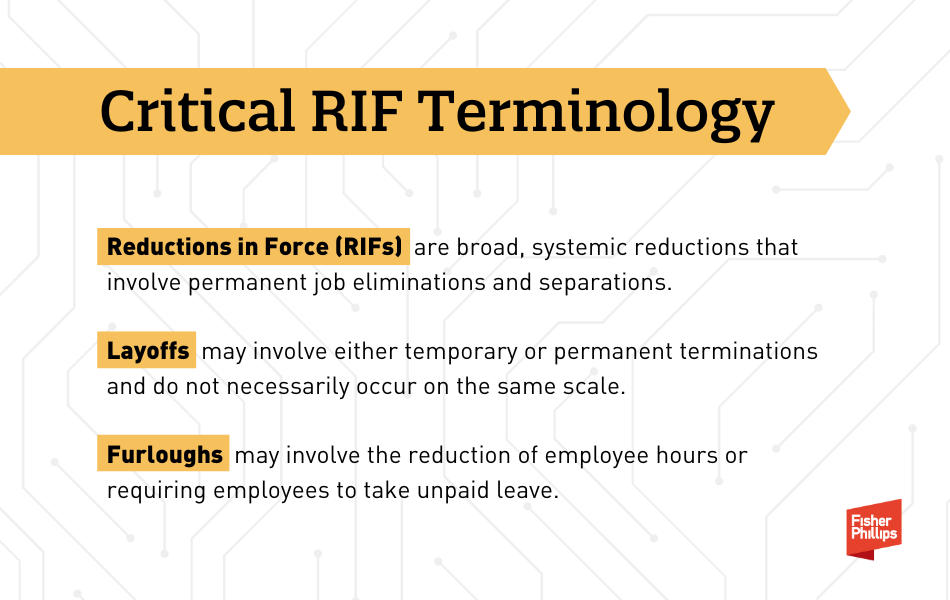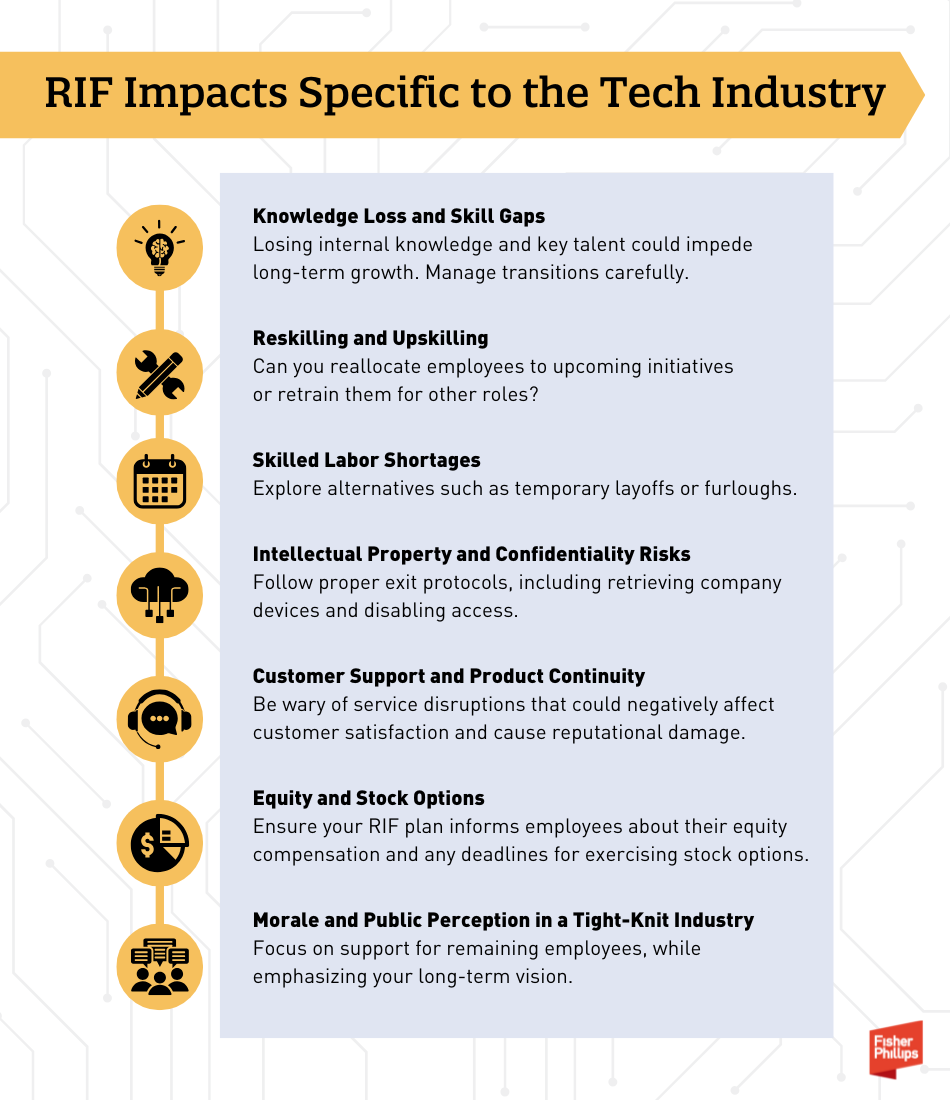Tech Employers Should Consider These 5 Key Issues Before Conducting Reductions in Force
Insights
10.28.24
Despite notable workforce reductions in 2022 and 2023, layoffs in the tech industry are still prevalent as 2024 wraps up. The layoffs range from large employers to smaller-sized startups that are focused on profitability and efficiency in the wake of increased hiring during the pandemic. It is crucial for tech employers to have a strategic plan for assessing potential reductions in force (RIFs) and the impact on their initiatives going forward. In this Insight, we provide employers with five key considerations you should keep in mind for managing and assessing RIFs in the tech industry.
1. What Does Recent Labor Data Show?
According to Forbes, the tech industry has laid off over 124,000 employees so far in 2024. While the U.S. Bureau of Labor Statistics projects that the headcount for tech employers will grow twice as fast as the overall U.S. workforce over the next decade, suggesting the industry in the long term, is in good health for the long term, we may see more turbulent times over the next year until the industry fully rebounds.
2. What Are the Critical Legal Issues With RIFs?
It’s important to understand the definitions of some key terms before we continue.
- It is important to understand that RIFs are broad, systemic reductions in your workforce and involve permanent job eliminations and separations from employment.
- In contrast, layoffs may involve either temporary or permanent terminations and do not necessarily occur on the same scale as a large RIF.
- Similarly, furloughs may involve the reduction of employee hours or requiring employees to take unpaid leave while they remain employed.
These particularities are important because RIFs are subject to specific rules under federal, state, and local laws that you need to consider before you proceed. They include the North American Free Trade Act (NAFTA), the Worker Adjustment and Retraining Notification (WARN) Act, and others. Requirements under these laws will impact your timing, your decision-making, your notification responsibilities, and other aspects of your action and considerations.
3. What’s the Impact of RIFs on Employee Benefits?
RIFs, layoffs, and furloughs all may have significant impacts on your rights and obligations with respect to its benefit plans. It is important to consider the benefit obligations in advance, including severance plan triggers, coverage during furlough or COBRA triggers for group health plans, and potential 401(k) impacts relating to partial termination as a result of the event. You must also evaluate your communications regarding the RIF, layoff, or furlough in light of fiduciary obligations as it relates to the rights of employees under your ERISA plans.
4. What Are Some Key RIF Resources?
Our Technology Industry Group offers several resources that cover best practices for handling RIFs and can help guide you through the difficult decisions related to reducing your workforce and how to handle them.
- Read our 7-Step RIF and Layoff Blueprintapplicable to employers in any industry.
- Check out this Q&A on Effective Communication Strategies During a Reduction in Force.
- Contact any member of our Reductions in Force Practice Groupor the Technology Team if you are planning a RIF or other layoffs.
- Consider our RIF/WARN Toolkit, which provides essential resources to help employers plan and properly carry out mass layoffs.
5. What are Some RIF Issues the Tech Industry Should Especially Care About?
In addition, look out for RIF issues specific to the technology industry. For example:
- Knowledge Loss and Skill Gaps. Reducing your staff risks losing critical internal knowledge and key talent which could impede long-term growth. Layoffs in R&D departments can especially have a long-term impact on innovation and the development of new products or services. You should manage transitions carefully to preserve institutional knowledge and employers with critical skills.
- Reskilling and Upskilling.You may want to assess whether workforce reductions could be managed by reallocating employees to upcoming initiatives. As tech evolves rapidly, retraining employees for other roles can reduce the need for layoffs and help retain valuable employees.
- Skilled Labor Shortages. Skilled labor is often in short supply in the technology industry. If you’re planning to implement a RIF, consider the long-term impact of losing skilled workers who may be difficult to replace when demand picks up again. You may want to explore alternatives such as temporary layoffs or furloughs for skilled positions to retain talent and be ready for future projects.
- Intellectual Property and Confidentiality Risks. In the tech industry, employees often have access to proprietary information, trade secrets, and intellectual property. When conducting RIFs, ensure that you follow proper exit protocols, including retrieving company devices, disabling access to sensitive data, and reminding employees of their ongoing confidentiality obligations. Consider using severance agreements to reaffirm non-disclosure and non-compete clauses where legally permissible.
- Customer Support and Product Continuity. Reducing staff in customer support, product development, or engineering roles can lead to service disruptions and negatively affect customer satisfaction. Consider whether reallocating resources or delaying certain product launches could minimize the impact of the RIF. It’s important to maintain continuity in essential customer-facing roles to preserve client relationships and avoid reputational damage.
- Equity and Stock Options. Many tech employees receive a portion of their compensation through equity or stock options. RIFs can trigger the need to address vesting schedules, stock repurchase agreements, and the treatment of unvested options. Ensure your RIF plan includes communication with affected employees regarding their equity compensation and any potential deadlines for exercising stock options.
- Morale and Public Perception in a Tight-Knit Industry. Tech companies are often closely watched by competitors, investors, and the public. Large-scale layoffs could not only affect morale but also harm your company’s reputation in the industry. Consider internal communication strategies that focus on transparency and support for remaining employees, while externally emphasizing the company’s long-term vision and stability to maintain investor and market confidence.
Conclusion
If you’re contemplating a RIF or other layoff, your Fisher Phillips attorney is ready to help. You may reach out to authors of this Insight, any attorney in our Reductions in Force (RIFs) Practice Group, or any attorney in our Technology Industry Team. We will continue to monitor the latest developments related to this area and provide updates as warranted, so you should ensure you are subscribed to Fisher Phillips’ Insight System to gather the most up-to-date information directly to your inbox.
Related People
-
- Brett P. Owens
- Partner
-
- Lorie Maring
- Partner
-
- Danielle H. Moore
- Executive Partner, Management Committee




